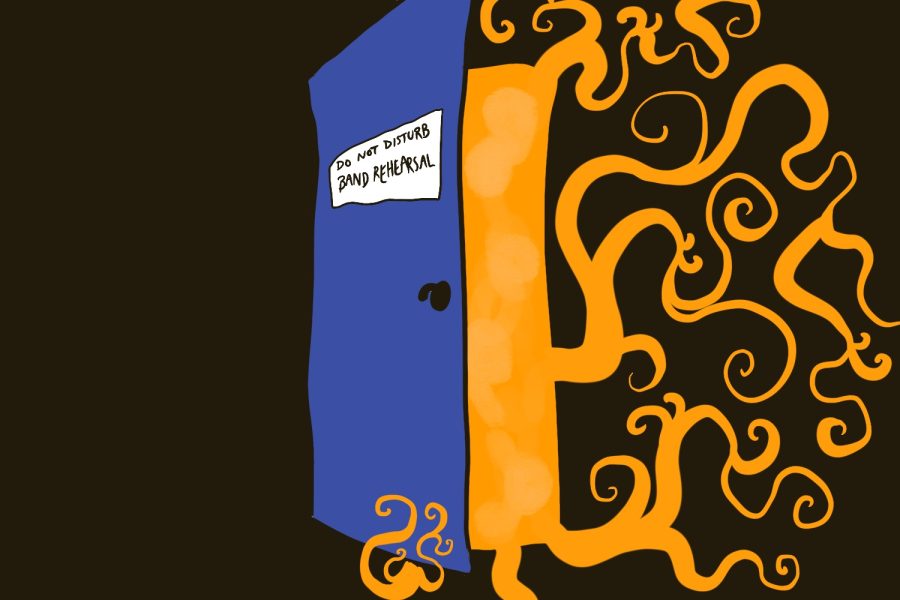Sitting in: The rehearsal process of student bands
November 29, 2022
Since coming to UVM, I’ve spent many weekend nights crammed in a smelly, unfinished basement or in a backyard downtown as an exciting and talented group of college musicians performs for a crowd.
Following the pandemic, student bands have regained traction as they’ve reclaimed the role of undergraduate weekend entertainment. It’s no wonder they have such a strong appeal—these shows create an atmosphere that brings people together with their exciting, casual and carefree environments.
While attending these shows, we rarely think of the effort these bands put into preparing. Hours of rehearsing, coordinating and developing their craft is necessary for a successful show. So, what does that preparation look like?
I reached out to a variety of student bands and attended their practices to observe their rehearsal methods.
While I was expecting all the bands to have very similar techniques, I found that it was quite the opposite—their approaches were very dependent on how long they had been playing and performing together as a band and the type of music being played.
Zonkey
The first band I met with was Zonkey. All four of their members are seniors and they have been a band since their sophomore year. The band includes Tucker Smith on guitar and vocals, Charlie Bradley on bass guitar, Ryan Salsburg on guitar and Justin Coudert on drums.
Upon my arrival at Coudert’s house downtown, I could hear a cover of “Sand” by Phish from outside. Smith came to the door to let me in and led me down a dark, musty stairwell to a messy and unfinished basement.
Equipment was strewn about the floor, the atmosphere was dank and dirty concrete walls surrounded the small space. I could tell immediately the rehearsal would be casual, laid-back and fun—perfectly matching the band’s funky but chill musical sound.
Zonkey is a jam band: a musical genre that emphasizes lengthy periods of improvisation and has a groovy rhythmic feel. They are largely inspired by popular groups like Goose and Phish.
The band tends to play mostly originals, which Salsburg and Smith write. Their first EP comes out in January and will include eight original songs that they have been playing live over the course of this past year.
Zonkey’s practice was a continuous jam: in an hour, they only paused the music twice to talk. Since they are a very established band with lots of successful gigs in their history and a strong following, they have a vast list of songs they can choose to play.
During this practice, they played lots of songs they already knew and had extended periods of improvised jams.
When they would move onto a different song, the guitarist would play a lick from it and the other members would pick that up, facilitating a very smooth transition regardless of the fact that it was completely unplanned.
At one point, they did a mashup of two songs, which was completely unintentional, Smith said.
Zonkey’s jam-band approach is very impressive, as it requires very little preparation, relies heavily on improvisation and demonstrates a distinct ability to pick up each other’s cues.
Scooberdiver
The next practice I attended was that of Scooberdiver, another highly-developed and successful band. The band has four members: juniors Jack Pitblado on guitar and vocals, Brendan Cox on drums, Henry Figler on keys and sophomore Kai Pasciak on bass guitar.
The rehearsal took place in one of the members’ basements. The space was messy with equipment scattered across the floor, much like that of Zonkey, though the room was large and had brighter lighting than Zonkey’s.
It also had more space to hang out, with couches and a table, so I had a very comfortable position to watch the band’s practice from.
The basement also functions as their laundry room, and at one point, a roommate entered the basement to change his laundry mid-song, weaving through the equipment and band members to reach the washer and dryer.
While the setting was similar to Zonkey’s, as it was messy and relaxed, Scooberdiver’s rehearsal methods were extremely different, mostly because of the type of music being played.
While Zonkey used the method of a constant and improvised jam, Scooberdiver tended to play their songs closer to the sound of the recording, resulting in a more structured practice.
At the particular practice I attended, Scooberdiver was rehearsing for a show they were playing that night, where they would perform the entirety of “Dark Side of the Moon” by Pink Floyd.
Since Scooberdiver was playing a specific album for this show, the rehearsal was different from their average band practice, so I asked them about what a standard practice usually looks like.
They play a mix of originals and covers at a regular session. For originals, Pitblado usually writes lyrics, and Figler usually writes instrumentals. When learning new songs, Scooberdiver’s members mostly learn by ear by listening to the song and then playing it themselves.
“We power through it for an hour and a half, see how terrible we sound, and after that it’s really rewarding because we learn a lot,” Pitblado said.
That high level of persistence and determination showed in the rehearsal, as they sounded very tight and skilled. I had a lot of fun at this rehearsal, and was extremely impressed with their ability to cover such an iconic album while also putting their own stylistic twist on the approach.
Lunch
The third band I observed was Lunch. They are relatively newer compared to Zonkey and Scooberdriver, so their practice was more driven by playing new songs, offering a unique perspective on the musical learning process.
The members of Lunch are sophomores Cece Murphy on vocals and Max Burka on guitar, first-years Adam Gansenberg on guitar and Evan Solnik on bass guitar and senior Sophie Powell on drums.
The band consists of mostly underclassmen, so their practice took place on campus. They made a common room in Ready Hall into their practice space, putting all of their equipment there.
The space had heavy natural lighting since one of the walls was entirely made of windows, creating a vibrant ambiance. It was messy with bikes up against the wall and random items across the table and chairs.
During this practice, Lunch was preparing for two upcoming shows, learning new songs that they wanted to put on the setlists.
When learning new numbers, they would play a song over their speaker, play along to the track, then play through the song until it sounded close to the way they wanted.
When members would mess up, they would often ignore it and keep playing, or they would sometimes pause and discuss what they wanted to do differently.
While learning “All The Debts I Owe” by Caamp, the band was initially having a hard time getting the hang of the song’s abnormal timing.
To work through the issue, Powell counted out beats as they listened to the song, and when they played through the song, she would count out loud as the members played.
Though this practice mostly focused on learning cover songs, Lunch also plays lots of originals. Some of their originals are written together as a band, in which Burka writes chord progressions and Murphy writes lyrics.
They also have several originals that members write individually and then teach to the rest of the band.
Out of the bands I observed, Lunch’s practice did the most work on new material.
Zonkey and Scooberdriver focused on perfecting songs they already knew, while Lunch emphasized developing new songs.
Overall, I found the development of the bands impacted how productive they were in their practice, and the type of music being played affected the rehearsal structure. All of the bands were very impressive, whether they were playing jam-band, acoustic or rock music.
I saw genuine enjoyment in the members of every band, which was extremely inspiring and wonderful to see. They like to have fun with their craft, driving the hard work that I got the opportunity to witness.







